4 Reasons Why You Should Implement Keyword Clusters in Your SEO Strategy

Freelance Writer at WilliamsTechCopy
What Are Keyword Clusters?
4 Benefits of Keyword Clustering
How To Create Keyword & Topic Clusters
A Content Audit to Optimize Your Existing Blog Content
Monitoring Your Keyword Clusters in GSC Insights
Is Keyword Clustering Really Supporting Your SEO Strategy?
Conclusion: To Cluster or Not To Cluster?
The practice of focusing and optimizing your website around a few core keywords is quickly becoming outdated. Each day, Google and other search engines are becoming increasingly adept at comprehending human language and search intent. For instance, Google is now putting more emphasis on natural language processing (NLP) and focusing all efforts on a deeper understanding of how on-page content interrelates. Consequently, it’s no longer enough to optimize content for a single keyword.
As Google’s (NLP) capabilities continue to advance, our on-page SEO strategy must also improve to reflect these advancements in search. This is why the SEO industry has shifted its focus to keyword clustering to level up on-page optimizations and keep up with Google’s technological advances.
But what is keyword clustering, and how does it breathe life into both new and existing content on your site? This article will explain what keyword clusters are and how structuring your website around them can help you drive organic traffic from search engines and grow your business.
What Are Keyword Clusters?
Simply put, keyword clusters/topics (also known as keyword groupings) are a group of similar queries and keywords representing searches with similar consumer intent. These terms or phrases have similar or almost similar meanings and intent.
For instance, “security camera,” “security camera for home,” and “security camera system” are nothing but similar keyphrases with similar intent used by Google searchers who want to buy a security camera.
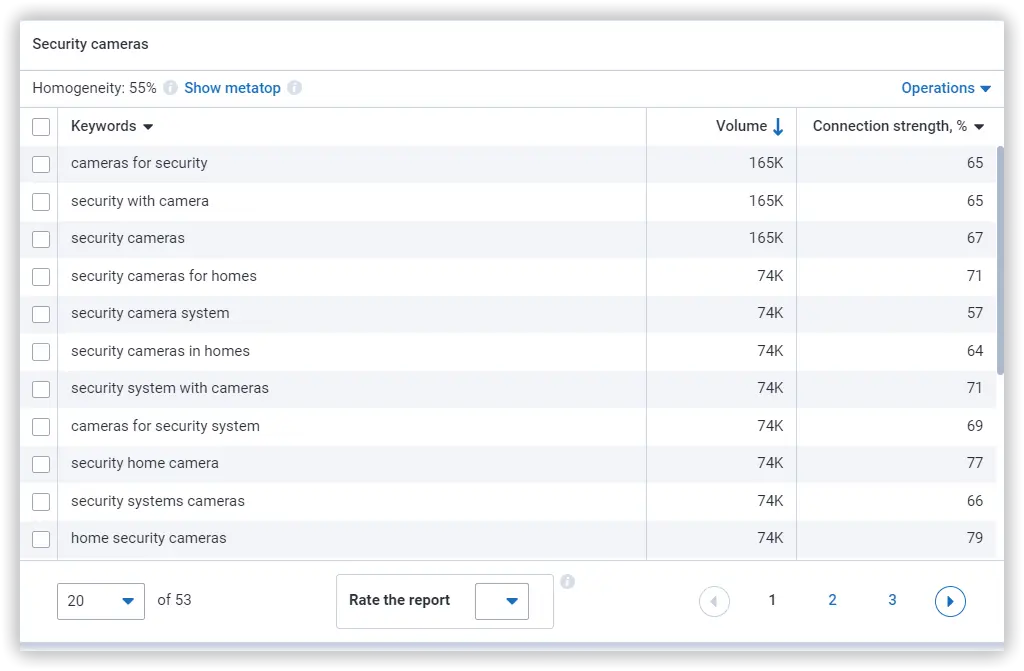
You can think of keyword clusters as multiple keys on one keyring where the keyring is your content, and the keywords/phrases are your keys.
Users rarely search for products, services, or answers to their questions using the same terms. So, assuming that your brand deals with security cameras, ranking for the first keyword only will limit your market share for the other keywords in the cluster.
Google typically ranks your web pages for multiple keywords anyway. Using a keyword cluster model is a great way to strategically ensure that Google ranks your pages for the most relevant industry keywords and the terms your target audience uses most frequently when searching.
4 Benefits of Keyword Clustering
To maximize the benefits of keyword clustering, you should first realize that it takes a lot of time and resources, and it’s not an overnight success approach for your marketing strategy. To be successful, you’ll need to do detailed keyword research, publish tons of content and invest more in your SEO efforts.
It’s also crucial to have an experienced marketing team and use high-quality project management and collaboration software to run your SEO campaigns. In addition to collaboration tools, the software must come with features such as keyword research and keyword clustering recommendations so you can develop a comprehensive keyword strategy.
With that said, here are some of the key benefits of keyword clustering:
Higher Organic Traffic
Gone are the days when on-page SEO techniques comprised optimizing each landing page of your website for a single focus keyword. Today, optimizing for a single keyword will limit your website’s potential to generate organic traffic.
With keyword clustering, you can target multiple related long-tail and short-tail keywords instead of just one, increasing the number of appearances in search engine page results (SERP). This will make the search engine perceive your pages as more relevant, which will help your website rank higher.
Additionally, it allows you to supercharge your content planning. This is because it forces you to think of better ways to structure your website around your keyword clusters and their relevance to your audience. In the long run, this makes it easier to identify the less competitive, high-conversion keywords which you can focus on to help strengthen your site’s authority and draw in more traffic.
It’s harder to gain momentum with a highly competitive keyword, especially if you are just starting. It’s better to start by focusing on creating content on subtopics that a closely related to your main topic — you will face less competition with these — to help establish your site on the search engine.
Another way to improve organic traffic to your website is by encouraging your clients to leave reviews about their experiences on your Google Business Profile. Google reviews play a huge role in local SEO, building customer trust and helping to attract more visitors and drive more traffic to your business. Since over 70% of customers would leave a review only if asked directly, you must be proactive to get buyers to take action.
Faster Ranking Improvements in the SERPS
In 2007, Google classified at least 25% of all searches entered into its search box as ‘new’ and never seen before. This number has consequently reduced, and from 2013 to date, 15% of all the queries entered on the search engine’s search box are considered ‘new’ and never seen before by Google.
Using keyword clusters diversifies your search potential and makes it easier for the search engine to understand your content and show it on SERPs for all the potential new keywords.
Let’s look at the security cameras example again. If you only optimize for the keyword “security cameras,” you lose the chances of cashing in for the keywords “security camera for home” and “security camera system.”
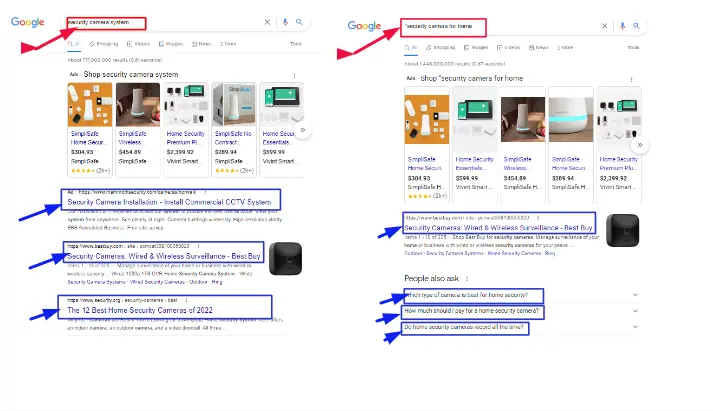
More Opportunities for Internal Linking
Your website is like a big mansion, with rooms and spaces interconnected to each other. And just like a house, your website’s internal design and architecture are very important. Internal links are like doorways from one page to another.
Google loves when there are enough doorways and when the doorways are logical and easy to follow. This is because both readers and search engine crawlers can have an easier time finding your content.
Google’s algorithm continually improves to provide searchers with the most relevant results. Among these modifications are penalizing excessively irrelevant internal connections and interpreting conversational requests as thoughts rather than literal keywords.
A pillar page is an extensive resource page that provides in-depth coverage of a primary topic and links to high-quality information developed for supporting subtopics. This makes it easier for consumers to find the relevant and correct content they require and simplifies the process for web crawlers to comprehend and relate themes on your website.
Using keyword clusters creates limitless opportunities for internal linking. And this comes with unlimited benefits that include:
- Enhances website indexation.
Search engine crawlers follow links to find and index your website pages. Internal links help the crawlers easily find, categorize, and index your content.
- Aids in website navigation.
Proper internal links help fresh and deep crawl bots easily navigate your website, which can get you on their good side and win you some rewards.
- Increases backlink earning potential of deep content pages.
Developing a well-thought-out internal linking strategy can boost your page and your content’s link juice earning potential. This is accomplished by providing explicit click routes and indexation on your website that raises your site’s crawl priority via improved link distribution.
- Increases authority and ranking power for all pages on your website.
The search engine algorithm employs a method significantly more intricate than link juice flow to determine the value of your content. Internal linking is one of the key things that helps the bots deem your content valuable. If your website is well-structured and indexed, you can achieve a high SERP ranking without relying on link juice alone.
- Internal links with well-chosen anchor texts improve link value.
Since internal links are a string of HTML code that links one web page to another, they are more valuable than navigational or image text. Adding a keyword to the anchor text can boost the value further.
- Offers site visitors more value.
Not only is using keyword clusters an important SEO technique, but it also provides a lot of value to site visitors. When most visitors investigate a certain topic, they frequently seek out more pages with complementary information. Users who appreciate your material will spend more time reading your other pieces.
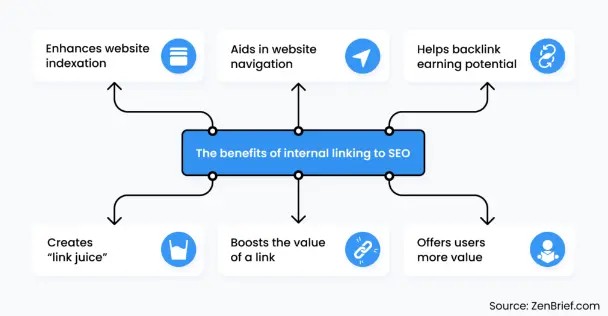
Building Expertise and Topical Authority in Your Industry Niche
To achieve topical authority, a piece of content must be able to influence the audience’s opinion or thought, which is achieved only if the content shares convincing arguments and strong evidence.
For a site to achieve topical authority, it must have some authority over a group of ideas or a niche rather than having actual influence over a single idea or area. According to this relatively new notion, websites with valuable and relevant material are ranked higher in Google’s search results than those with irrelevant content.
For example, let’s say you have a page on pink Barbie dolls on a website that discusses everything related to Barbie dolls. At the same time, another brand has a similar page for pink Barbie dolls, but the page is on a website about beauty products.
Assuming that you are marketing Barbie dolls and not pink-colored products, your website has higher topical authority.
That’s because although the beauty products site might have a great page on pink Barbie dolls, there is nothing to signal the search engine or the readers that they have a vast knowledge of these dolls. On the other hand, your website has topical authority on Barbie dolls, and it could easily be a one-stop shop for all things dolls, whether the reader wants to learn about pink or orange Barbie dolls.
In short, keyword clusters can help you generate high-quality content on your specific topic. So whenever readers search for information or relevant sites to link to, you will be where they go.
Improved Rankings for Long-Tail and Short-Tail Keywords
Standalone keyword marketing strategies belong to the past. Using keyword clusters with a good mix of long-tail and short-tail keywords increases your chances of ranking for keywords that can be hard to manage alone.
For example, as time passes, long-tail keyword techniques are becoming more and more crucial for SEO. This results from Google’s emphasis on user experience and intent, the rise of conversational search, and the advent of applications such as voice search.
With clusters, you can rank for various long-tail and short-tail keywords instead of targeting a few search queries separately, consequently increasing conversions and revenue for your company.
For example, here’s a business that is probably targeting multiple keywords with this piece of content. It ranks first for both “content brief” and “what is a content brief” keyphrases.
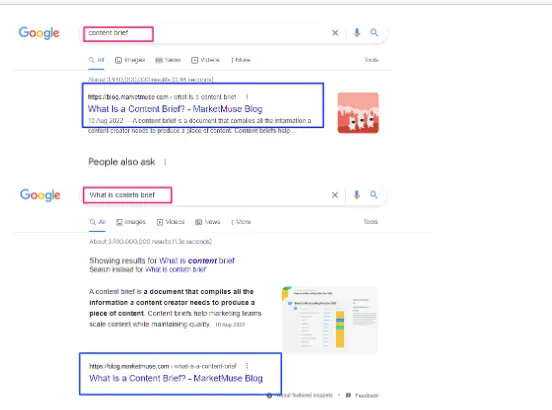
Here is how you can increase your chances of ranking higher for both long-tail and short-tail keywords:
- Don’t razor-focus on a few main keywords. Instead, always include a good mix of long-tail and short-tail keywords in all pieces of content.
- Ensure you have a full grasp of the why or the user intent of each particular keyword so that you can tailor your content to cater to that intent.
- Google still checks if the keyword entered in the search box is well distributed in the content. Ensure that your keywords are included in your headings, H1 tag, meta description, and even image alt texts.
- Ensure that you have a good architecture of internal links between your pillar pages and cluster pages.
How To Create Keyword & Topic Clusters
Developing a keyword cluster requires extensive keyword research and being strategic about how you target your chosen keywords. You must understand your target audience and the types of search phrases they use to search for similar answers, services, or products.
Here’s a step-by-step guide on carrying out keyword clustering and successfully building a content strategy around the clusters:
Step 1: Make a Keyword List
Before you can start targeting keywords, you must do keyword research first - lots of it.
To start, think of the main keyword you want your site to rank for. For example, let’s say your business is an e-commerce brand that sells women’s running shoes. An example of the primary keyword you can rank for would be “running shoes for women.”
Once you have identified the main keyword, identify all the possible subtopics, long-tail phrases, pillar topics, synonyms, and variations around this keyword.
Also, consider checking which keywords your competitors are ranking for to see which are most popular in your industry. The idea is to find which terms are more valuable and possess the highest conversion potential.
To get you started, here are questions you should ask yourself when doing keyword research:
- What am I selling?
- What problems does my target audience need to solve?
- What would make potential customers choose my website over other similar ones?
- What demographic of customers am I targeting?
- If I was a brand new customer, what terms would I enter and search on Google to find my products or services?
- Do I have any existing content that answers my potential customers’ most common questions?
Once you have a quick list of the main keywords to target, you can use a keyword tool to identify more potential keywords.
Step 2: Use a Keyword Research Tool To Analyze Your Keywords
Next, use a reliable keyword research tool to find out which of the keywords you have listed are valuable and have the potential to bring traffic to your website.
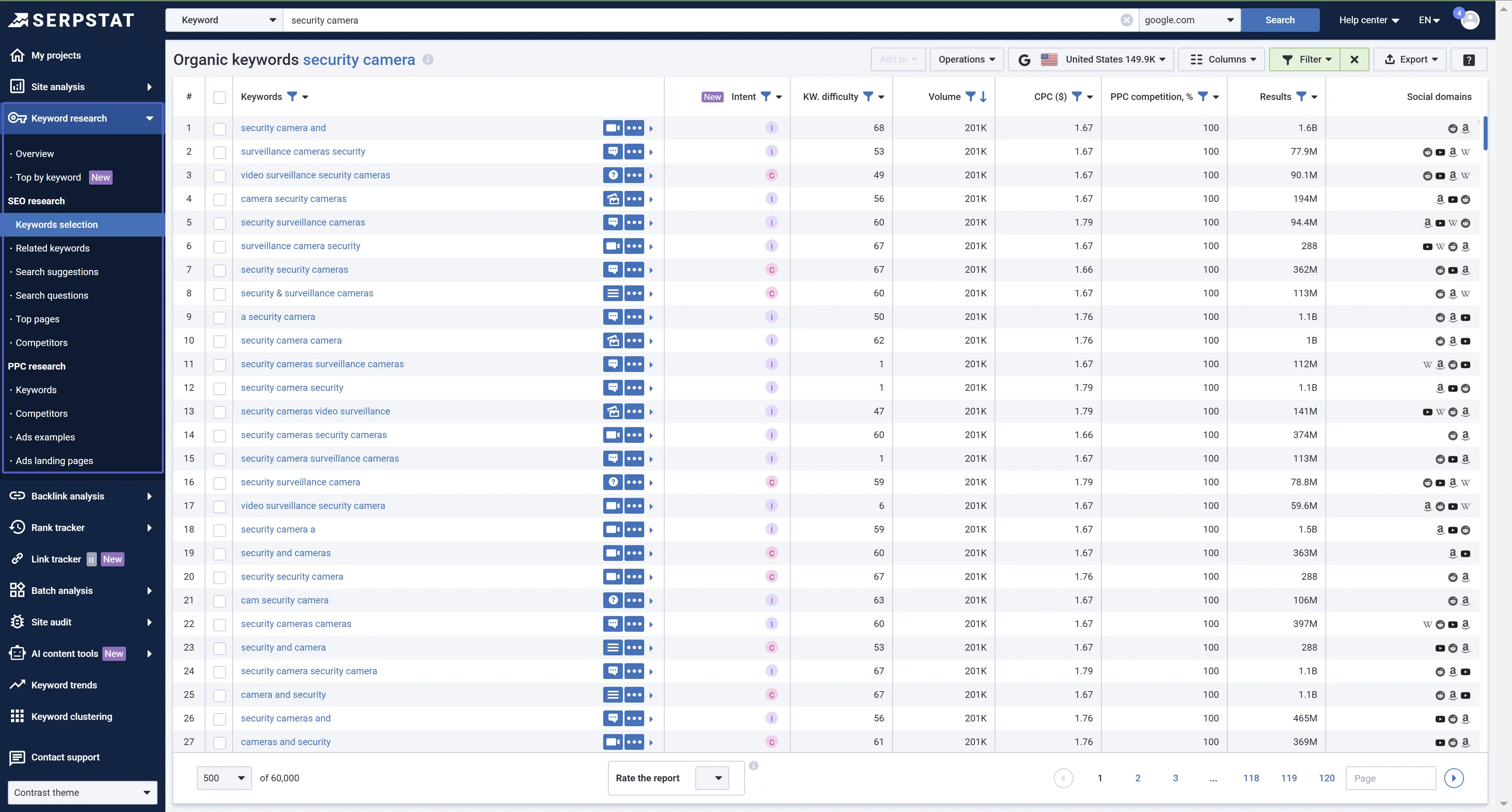
There are many ways to record your research results. Depending on your keyword research tool, the easiest is to download the data as a spreadsheet.
Here is an example:
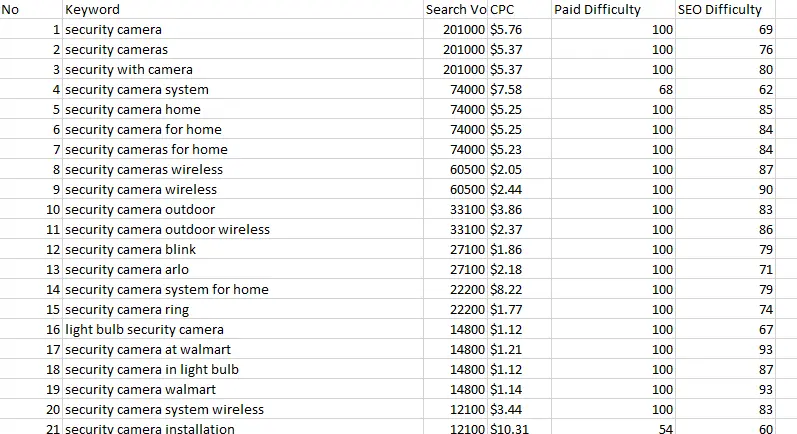
If done correctly, extensive keyword research can give you a list of hundreds or even thousands of keywords that have the potential to bring more traffic to your website. This data will help you identify which keywords your target audience uses more when searching for products and services like yours so that you can prioritize them as “core” keywords in your clusters.
Step 3: Identify Themes and Topic Groups
Once your keyword list is ready, you will quickly notice similar themes and patterns. In fact, you may have already started noticing various similarities while doing your research. These patterns are what will help you form keyword clusters.
Here are some criteria you can use to segment your keyword list into clusters.
- Relevance.
Aim to group words and phrases that are closely related and have the same search intent. This will make it easier for Google to access your pages and quickly gain insight into the content.
- Search volume and CPC.
Your core keywords should have a decent search volume, proving that people are actually searching for these keywords. Long-tail phrases might have fewer searches since they are very specific, but ensure they have good cost-per-click metrics.
- Organic difficulty.
Various ranking factors come into play when it comes to organic difficulty. Typically, including keywords with greater organic difficulty will depend on your site authority and your website’s establishment. Combining low- and high-competition keywords can boost short-term rankings.
- Marketing funnel.
It’s also possible to group keywords based on where the customer is located in your marketing funnel. For example, the top and middle of the funnel can have awareness and lead-nurturing keyword clusters (best for ebooks and blogs), and the bottom of the funnel can have conversion keyword clusters.
Step 4: Organize Your Keywords Into Groups
Once you have figured out the commonalities, organize the keywords into groups of about 3-5 — more than this might be troublesome to optimize. You can rely on any reputable SEO tools like to carry out this process.
Ensure that every cluster has got a core keyword and several complementary keywords. For instance, you can include a lower-difficulty, high-search volume keyword with a few long-tail, low-search keywords.
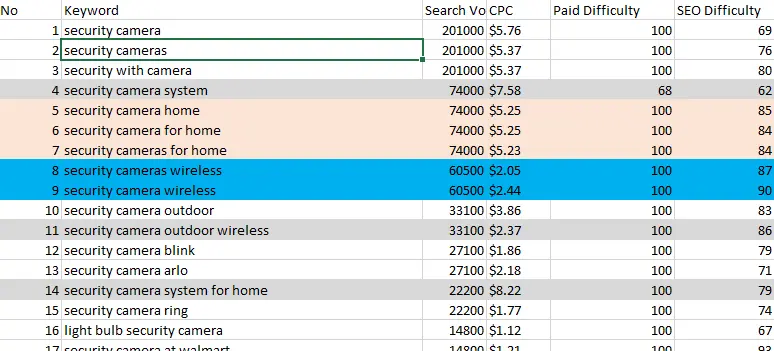
In such a case, the core keyword might be slightly more competitive to rank for, but you have paired it with lower-difficulty keywords with slightly higher conversion potential.
Also, remember that not all keywords on your list should end up in a cluster. Only pick out the ones with high CPCs, substantial search volume, and relevant search intent, and use only these to make your keyword clusters.
Step 5: Create or Optimize Pillar Pages With the Keyword Clusters
Now that you have your keyword clusters, they will work as the roadmap to your highly optimized pages. Use the clusters to create, optimize and generally organize the content on your website.
Typically, each keyword cluster represents one core topic, or what is known as a pillar page. You must have a landing page for each keyword cluster to optimize properly. You can also use a content optimization tool to help you better optimize your content.
Ideally, you should analyze the keywords that form each cluster to see what information you need to share and how you can help ease your audience’s pain points.
After creating your initial web pages, you will need to extend your content to strengthen your keyword clustering efforts. You should not only consider the material you publish today; instead, you should concentrate on developing a sustainable content strategy that supports your website’s long-term SEO.
Prioritize the following areas to increase pillar page rankings:
- Topical depth:
Write long-form content with enough depth.
- Information structure:
Ensure your content is well-engineered and has structure and flow.
- Page experience:
Focus on writing for humans before you write for the search engine. Include on-page nuggets like images, videos, and jump links to improve the page’s user experience.
Step 6: Reinforce Keyword Clusters Using Blog Content
Building blog content around your pillar pages helps reinforce your keyword clusters, thus increasing the ranking and content authority of the pillar pages. Each blog post can focus on one of the supporting keywords — subtopics or keywords related to the core keyword. This will help you to form topic clusters for your website automatically.
However, the internal linking strategy between these pages also plays a big role in helping them rank well on Google. Typically, the subtopic pages should link back to the pillar pages with the core keyword to help increase the chances of ranking higher for these keywords.
Building topic clusters on your website allows you to add more internal links, increasing the time users spend on your pages. It also helps Google crawlers quickly identify which pages are most important.
A Content Audit to Optimize Your Existing Blog Content
The truth is, it’s easier to repurpose existing content and attract more traffic than to rank for new content.
So to rank more quickly for the keyword clusters, you should:
- Perform a content audit and identify existing pieces of content that can be spruced to gain more verticals. For instance, you can find cluster articles that could work well if linked to certain pillar pages.
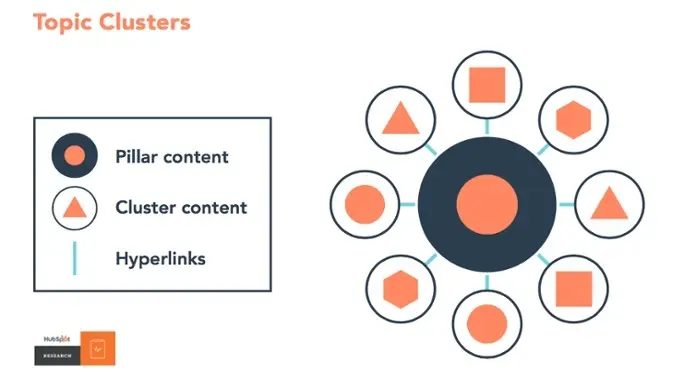
- Also, identify pieces of content that need more depth of information or subtopics in an existing article that could be covered better on a standalone page. Keeping content up to date and eliminating false or misleading information is a part of practicing good digital citizenship that helps provide value to your audience. You can check your Google Search Console (GSC) for insight into what topics your audiences are searching for the most and maximize their potential.
Monitoring Your Keyword Clusters in GSC Insights
Once you have finished keyword clustering and published optimized content around these clusters, it’s also important to track the keywords to see how they rank.
Here are the key things to track to find out if your new SEO strategy is working:
- The number of keywords ranking.
If the overall number of keywords your page ranks for increases, it indicates that Google truly understands the page’s content and recognizes its relevance for various keyword searches.
- Impressions.
If Google starts promoting your SERP result to an increasing number of searchers, it indicates that their crawlers consider your page relevant. Even if your page is not ranked on the first page, impressions mean that Google considers your pages relevant to the keyword query.
Is Keyword Clustering Really Supporting Your SEO Strategy?
Keyword clustering might be a long game, but it’s all worth it in the long run. It’s part of an advanced SEO strategy that can give you an edge against Google’s two main superpowers (natural language processing and indexing), so you can win some verticals.
When you base your website around keyword clusters, you are telling Google that your site is an authority in your niche and contains a huge breadth and depth of content. Thus, keyword clustering is not only beneficial to your current SEO strategy, but it is also the future of SEO in general. Utilizing this technique now will put your website ahead of the park and set it to rank for the long term.
Conclusion: To Cluster or Not To Cluster?
As you can see, a lot goes into creating a winning SEO strategy. Google is continually evolving and developing itself, so you need to keep evolving to stay relevant too. Keyword clustering is one of Google’s greatest inventions that allows you to create, optimize, and organize your content by diversifying your language to rank higher and quicker.
Keyword clusters make your content look more in-depth and show your audience and the search engine that you understand your niche. Additionally, in-depth content aids in covering all possible user intent and helping your audience get all the answers they seek from one source, which builds your site’s authority.
Start Finding
Keyword Ideas
Sign up and try for free
Discover More SEO Tools
Backlink Cheсker
Backlinks checking for any site. Increase the power of your backlink profile
API for SEO
Search big data and get results using SEO API
Competitor Website Analytics
Complete analysis of competitors' websites for SEO and PPC
Keyword Rank Checker
Google Keyword Rankings Checker - gain valuable insights into your website's search engine rankings
Recommended posts
Cases, life hacks, researches, and useful articles
Don’t you have time to follow the news? No worries! Our editor will choose articles that will definitely help you with your work. Join our cozy community :)
By clicking the button, you agree to our privacy policy.